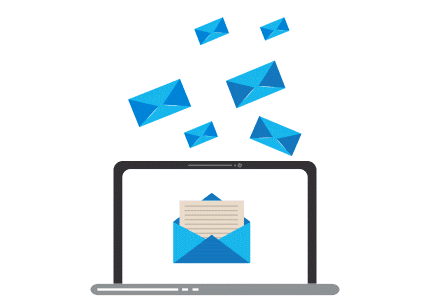
The plain old email is still one of the most effective marketing channels, but it now requires some sophistication to get the best results. With people and machines more sensitive and quick to discard email as spam, you need to make sure your email campaign is done right!
Here is a guide with the most important elements to build an awesome email campaign:
1. Plan
An email campaign strategy can be a project in itself, so before you fire away an email blast you should at least answer THE question:
What is the objective of the campaign?
The answer to this question will guide you to focus on the relevant elements. Once you have the answer to the big question, you can also address some additional points in your strategy plan:
- Do you need a landing page?
- Who is the audience?
- What is the campaign duration? How many emails will you send? Do you need a drip campaign?
- Do you need to adjust the flow and content based on triggers (workflow automation)?
- What are your goals? This can be as simple as ‘send 2 campaigns per month’ to ‘improve conversion from idle accounts by 27%’. Start simple and keep raising the bar as you achieve your goals!
Tip: do not even look at any tools before you can answer these questions, as the service provider selection should depend on your objectives.
2. Define audience
In your strategy plan you should have identified who your audience is. The most important point is to make sure you have permission to be emailing this list. If you are not sure, it probably means you don’t – so play it safe! Many email campaign providers offer tools and checks to help you create and maintain a healthy audience.
- Do you have an existing list, or are you looking to get subscribers?
If you have an existing list of recipients, you should make sure you complete the list as best as possible. This will later allow you to better segment your audience and customise your messaging, which can dramatically affect the effectiveness of your campaign.
If you are looking to build a new list, forms on websites or social media are 2 of the most common ways to capture emails. Solutions like OptinMonster are a good way to present an offer and get more people to sign up to your list. There are usually no easy gains, and you need to aim for a long strategy in order to build a quality audience.
Remember… the best way to maintain a healthy subscriber base, is to respect it and keep offering something of value!
- Strategic segmentation
Whether you have a new list or an existing list you NEED to segment it. Segmenting your audience will allow you to better manage the list, customise the content, and most importantly will force you to think that strategically about the messaging and overall approach for each segment.
As a very simple use case, imagine a shop sending an email about new arrivals. Customizing the message based on previous buying habits should almost surely increase engagement.
Or, let say you are sending an email about an upcoming technology conference. You could segment your list and send a different message with the specific benefits to attract startups, investors, and tech companies.

- Manage your list
This part of the campaign is an ongoing process. Yes, all email campaign providers will help you do some housekeeping (managing unsubscribes, whitelisting or blacklisting emails and domains according to deliverability) but make sure that you maintain good records, especially if you are using multiple email campaign providers, or if you integrate you email campaign software with other tools, such as your CRM.
3. Choose an email campaign provider
With your strategy and audience defined, you can now search for your email campaign service provider.
There so many solutions out there and the depth of features and pricing options span beyond the limitations of a comparison table. There is no single ‘best’ provider but here are some very capable solutions: Mailchimp, Sendgrid, Adestra and Campaign Monitor are definitely good all around solutions, while more complete marketing automation solutions like Hubspot , Marketo or CoSchedule can offer some additional functionality beyond email campaigns.
Things to keep in mind:
- Make a shortlist of providers and see which one has the features to better meet your needs. Some providers may offer a great interface and design features, while others may be more powerful in customisation and workflow automation options
- Watch out for very attractive pricing offers that will only turn very expensive when your list grows or if you reach certain volumes
- Evaluate the various add-ons and see if there are any extra fee for any of the ones you will be needing
- Will this tool allow you to grow as your email marketing needs increase?
It’s important to note that there is also a level of commitment in the sense that it’s not easy to shift your campaign provider. Not without losing some of the data such as stats, list segmentation, and changes in status. So if you are planning to test and benchmark, I would advise to do so with a small sample list or a demo account.
4. Designing your email
Any email marketing expert will frown at the word ‘template’, but templates can actually be a great source of inspiration. Here are some good examples:
https://blog.hubspot.com/marketing/email-marketing-examples-list
https://coschedule.com/blog/email-marketing-examples/
https://sumo.com/stories/email-marketing-examples
- Design
From the design perspective, a template is a great way to make sure you have a visually stunning email, that works on all devices and without the need for any graphic design skills. Make sure that your are providing substance in the preview part of the email, as many times that will make the recipient decide whether to open your email or not.
- Content
No magic recipes here… A successful and well received email in one part of the world, might be ignored or even deemed offensive in another part. This is where the knowledge of your audience and segmentation comes into play. Remember, a successful email should look and feel personal, and you should spend the time to craft a good copy. Just make sure you don’t forget about the pre-header – this gives you a great chance to complement your subject line and provide a catchy summary.
- Action! Call to Action (CTA)
As part of your strategy, you should have a clear goal for each email you are sending. In each case the CTA (or multiple CTAs) must be clearly presented and easy to spot! Don’t hesitate to try multiple CTAs, for example at the beginning and ending of the email!
5. Optimise performance
Optimising your email campaign strategy is once again a project in itself. Depending on your objectives, there are many parameters to monitor, track and optimise, such as open rate, click-through rate, conversion rate, unsubscribes etc.
To optimise your campaign you will need to master these:
- Avoid Spam Filters
-
- Make sure your lists only include opted-in recipients
- Use a ‘clean’ IP to send your campaigns. Most email service providers can provide a score and suggestions to improve this
- Limit the use of certain words that can easily be flagged as spam, such as “special offer”, “buy now”, “discount” etc.
- Include the unsubscribe links in the footer, as an easy way for subscribers to opt-out of your emails
-
- Choose the best delivery times
You can research on the best times to send your emails, or simply A/B test different options. In any case, make sure you consider the time you want the email to appear in the recipient’s inbox. This is especially important if you have recipients in different timezones! Remember, segment and schedule accordingly. Some providers like Mailchimp offer the option to automatically send emails at the time of highest open rate probability.
- A/B test
It’s very easy to get excited with the reports provided by your email provider, but plan your A/B tests carefully in order to get significant results. It’s strongly suggested to focus on one of the factors below in every test, and make sure you are testing with a significant volume of recipients (your email campaign provider can support you in this).
-
- Subject lines
- Content / text
- Content / images vs plain text
- Call to action
- Sender name
- Day/time sent
-
Happy emailing!
Updated on 28 Sep 2021.
Related Posts:

